

B ![]()
![]() p
p ![]() a
a![]() g
g![]() e
e![]() s
s![]()
![]() a
a![]() r
r ![]() e
e ![]()
![]() d
d![]() e
e![]() d
d![]() i
i![]() c
c![]() a
a![]() t
t![]() e
e![]() d
d ![]()
![]() t
t![]() o
o
J![]() e
e![]() f
f![]() f
f
![]()
![]() B
B![]() i
i![]() l
l![]() l
l![]() i
i![]() n
n![]() g
g![]() s
s
B - When found on a tube or other container of paint, indicates a color of less than permanent quality, though fairly durable.
|
code |
degree of color permanence |
|
highest |
|
|
standard |
|
|
B |
less than standard, though fairly durable |
Babylonian art - See Mesopotamian art.
baby ![]() spot - A
spotlight of 500 watts or less. Or, a very small design
or illustration.
spot - A
spotlight of 500 watts or less. Or, a very small design
or illustration.
Also see clip art, dingbat, glyph, thumbnail sketch or thumbnail image, and vignette.
background - The part of a picture or scene that appears to be farthest away from the viewer, usually nearest the horizon. This is the opposite of the foreground. Between background and foreground is the middle ground.
Also see depth, perspective, and wash.
back iron - In sculpture modeling, a metal frame set on a wood base, which is attached to an armature and supports the weight of material being modeled.

![]()
 backlight or back lighting - Light coming from
behind a subject. Or, to create
this effect.
backlight or back lighting - Light coming from
behind a subject. Or, to create
this effect.These photographs and the pictures below present examples of backlit subjects. English speakers sometimes use the equivalent in French, contre jour.
If you're looking at a computer monitor right now, the entire screen is an example of a backlit image.
Further examples:
Georg Balthasar Probst (German, 1732-1801), after P. van Blankaert, after Johannes Nieuhof (Netherlands, 1618-72), Le dedans du palais de l'Empereur de Chine à Peking (View of the Imperial Chinese Palace in Beijing), 1766-90, etching, engraving, watercolor, and gouache, 12 1/2 x 17 1/2 inches, Getty Research Institute, Malibu, CA. This is one of 22 objects in the Devices of Wonder exhibit catalogued online by the Getty Museum — best seen with Flash and RealAudio plugins.

Marie-Denise Villers (French, 1774-1821), Young Woman Drawing, 1801, oil on canvas, 63 1/2 x 50 5/8 inches (161.3 x 128.6 cm), Metropolitan Museum of Art, NY. Although it is not known for certain if this is a self-portrait, it might be. See feminism, feminist art, and Neoclassicism.
Also see projection and puppet.
bad art -
Quotes about bad art:
Another resource concerning bad art:
Also see academic, art, banausic, bland, brummagem, buckeye, calendar painting, camp, confection, decoration, decorative, decorative arts, derivative, gewgaw, hooptedoodle, kitsch, low art, mediocre, paint-by-number, ornament, picturesque, popular culture, pornography, quotations, taste, tchotchke, and ugly.
bad-debt art - Art that is sold or donated
because the owner is deeply in debt. When a work of art attains
this status, its market value
is typically much lower than it had been recently. This term has
been seen in both American and British publications since its
first known uses in articles about the failure of the booming Japanese economy,
which took place in 1991. The context in which this term was most
frequently used was in telling such stories as that of the Japanese
businessman named Saito who purchased
failure of the booming Japanese economy,
which took place in 1991. The context in which this term was most
frequently used was in telling such stories as that of the Japanese
businessman named Saito who purchased Vincent van Gogh's Portrait
of Dr Paul Gachet for 82.5 million US dollars in the 1990,
a record price for any work of art. Saito was shortly forced by
financial difficulties in the 1990s to sell the painting at a
loss (its current whereabouts not publicly known).
Also see deaccession, patron, and Post-Impressionism and Vincent van Gogh.
bailee - One to whom the property of another — the bailor — is entrusted for a limited period. A museum that has assumed temporary custody of an object is a bailee.
bailey - In the architecture of a castle, the outer wall or the open area enclosed by this outer wall.
bailor - One who entrusts his or her property to another — the bailee — for a limited period. An individual from whom or an institution from which a museum object is received, that is, the owner of the object, is a bailor, and may also be called a lendor or depositor.
Also see patron.
balance - A principle of design, balance refers to the way the elements of art are arranged to create a feeling of stability in a work; a pleasing or harmonious arrangement or proportion of parts or areas in a design or composition. Portions of a composition can be described as taking on a measureable weight or dominance, and can then be arranged in such a way that they appear to be either in or out of balance, or to have one kind of balance or another. Balance can be symmetrical, or formal; or it can be asymmetrical, or informal. It can also be radial.
Balance comes to us from those devices having two pans or plates, and a pivoting suspension from a central axis that permits comparison of the weights of things on the two pans. When the weights on the two sides are equal, the pans are level — balanced. One need know only the exact weight of things on one side, because when the device is level, the unknown weight must equal the known one. Linguistically, the origin is in Latin: bi meaning two is joined to lancia meaning pans.
Symmetric balance occurs when the two sides are identical — they reflect each other: Latin syn meaning same is joined to metric meaning measure. Asymmetric balance is different: the Latin prefix a- means not, so asymmetry lacks balance; it is off-kilter. Radial balance is the kind found in another device: a gyroscope — essentially a spinning wheel.
Example:

Young Woman with a Water Jug by Johannes Vermeer (Dutch , 1632-1675), oil on canvas; 18 x 16 inches (45.7 x 40.6 cm), Metropolitan Museum of Art, NY. This painting is renowned for the elegant asymmetrical balance of its composition.
Quote:
Also see concatenation, counterpoise, direction, equilibrium, equipoise, homogeneity, horror vacui, tension, and trabeation.
balcony and balconette - In architecture,
a balcony is  platform that projects from the wall of a building
and is surrounded by a railing, balustrade,
or parapet. Because the balcony pictured is so small — projecting
shallowly and from only one window — it may also be called a
"balconette." Or, a gallery
that projects over the main floor in a theater
or an auditorium.
platform that projects from the wall of a building
and is surrounded by a railing, balustrade,
or parapet. Because the balcony pictured is so small — projecting
shallowly and from only one window — it may also be called a
"balconette." Or, a gallery
that projects over the main floor in a theater
or an auditorium.
Also see balustrade and niche.
baldacchino - In architecture, an ornamental canopy on columns over a tomb, altar, or throne; sometimes portable.
These may be the largest examples in the world:
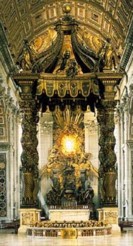
Gianlorenzo Bernini (Italian, 1598-1680),
Baldacchino,
1624-33, a Baroque
work, covering the high altar
of Saint Peter's Basilica, Vatican, Rome, height
100 feet. See basilica.
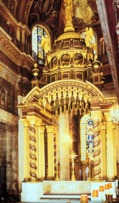
Christopher Wren (English, 1632-1723), The
Baldachino
of St. Paul's Cathedral, London. St. Paul's was constructed
1675-1710. See cathedral.
ball clay - In ceramics, an ingredient included in a many clay bodies because of its plasticity. Ball clay may be black or gray in color but fires almost white. It contracts considerably as it dries and when fired.
balloon framing - In architecture, a system of light timber-frame construction in which uprights or studs extend the full height of the frame and horizontal structural members are nailed to them.
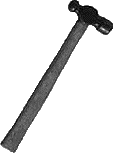
ballpein hammer - A hammer which has one side of the
head  flattened
for striking, and the other rounded for flattening rivets or forming a dome.
flattened
for striking, and the other rounded for flattening rivets or forming a dome.
Also see bush hammer, claw hammer, mallet, and nail.
balustrade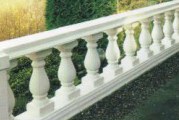 - A rail, usually about three feet high,
supported by a series of posts (balusters), generally as along
the outside edge of a stairway
or gallery.
- A rail, usually about three feet high,
supported by a series of posts (balusters), generally as along
the outside edge of a stairway
or gallery.
(pr. BA-lə-STRAYD)
Examples:
Balustrades of stone offered by stone-palace.com.
Also see balcony.
bamboo - Bamboo is a fibrous plant, and materials obtained from it. Bamboo grows into poles comprised of segments with hollow cores, gradually tapering to their upper tips. Leaves grow from the ridges at the ends of its segments. These ridges are distinctively dark in color. It can be found in widths up to several inches in diameter.
Commonly grown in many parts of Asia, bamboo has been used for millennia as a material in architecture, sculpture, furniture, and the making of a wide variety of implements, including brushes. Bamboo has also been an important subject for painters.
Bamboo's outer surface does not easily accept a stain, paint, lacquer or varnish. Bamboo has a certain brittle quality, with a tendency to split and splinter. Bamboo resembles rattan and is often mistaken for it.
Examples:

Li Kan (Chinese, 1245-1320), Bamboo and Rocks, 1318, pair of hanging
scrolls; ink
and color on silk, each: 74 3/4 x 21 3/4 inches (189.9 x 55.2
cm), Metropolitan Museum of Art, NY. See Chinese art and Yuan dynasty.

Wu Chen (Chinese, 1280-1354), Manual of Ink — Bamboo, 1350, ink
on paper, National Palace Museum,
Taipei. See chop.
![]()
Wen Zhengming (Chinese, 1470-1559), Bamboo, Orchids, Rock, and Calligraphy,
Ming dynasty, c. 1530, handscroll; ink
on paper; signature: seals
of the artist in inscription;
seals: (upper) Wen Zhengming yin, (lower) Zheng-Zhung, Worcester
Art Museum, MA. See calligraphy.

Nagasawa Rosetsu (Japanese, 1754-99), Bamboo, 1790s, six-panel folding screen; ink
on paper; no
signature; seals: (upper)
Nagasawa, (lower) Gyo, Worcester Art Museum, MA. See Edo
period and landscape.
Also see baren, basketry, cane and caning, dowel, nib, pen, raffia, reed, and rush.
banal - Boringly commonplace and predictable. Trite and obvious.
A ban once meant a widely proclaimed order, originating in the Indo-European bha, "speak." Marriage banns, proclaiming a couple's engagement, are still publicly posted by some Christian churches. A French boulin à ban or four à ban was a mill or an oven which the lord of the manor provided for his tenants to use in common in return for a share of the output. To the French, and then the English, banal came from this idea of the common or usual.
(pr. bə-NAL, BAY-nəl)
Quote:
banausic - Predominantly suggestive of functional and practical usage rather than decorative or ornamental. Or, common, ordinary, and undistinguished; dull and insipid.
Also see bad art, bland, gewgaw, hooptedoodle, and realia.
banco - A wet mud construction process akin to coil pottery. It is commonly used in parts of Africa.
Also see adobe.
b and w - Abbreviation for black and white.
Also see gradation, grisaille, monochromatic, neutral, photography, and value.
banker - A heavy wooden workbench, which sculptors use to support work being carved or model. The top may be fitted with a turntable so the work can be easily rotated.
In the painting seen below, the marble Pygmalion has been carving has come to life on his banker.
![]()

Jean-Léon Gérôme (French,
1824-1904), Pygmalion and Galatea, c. 1890, oil
on canvas, 35 x 27 inches
(88.9 x 68.6 cm), Metropolitan Museum of Art, NY.
Also see dolly, gantry, modeling, modeling clay, and modeling tools.
baptistery - A building used for baptism in the Christian church. A famous example is the Baptistery of the Duomo, the cathedral in Florence, Italy. Also spelled baptistry.
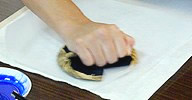
 baren
- In Japanese
printmaking tradition,
a small, flat pad of woven
bamboo bark used to impress
a print from a wood
block.
baren
- In Japanese
printmaking tradition,
a small, flat pad of woven
bamboo bark used to impress
a print from a wood
block.
barium - An inert white mineral used to extend colors and as a base for dyes. A soft metal, barium is used to deoxidize copper, bronze, and some other alloys. Elemental symbol Ba; atomic number 56; atomic weight 137.34; melting point 725°C; specific gravity 3.50; valence 2.
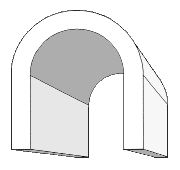
barrel vault - In architecture, a half-round ceiling made by placing a series of arches from front to back. Traditionally constructed in stone, it is also known as a tunnel vault, it was developed by the Romans and adopted later by Romanesque church builders.
bar tracery - Tracery using stone ribs in complicated patterns.
Also see architecture, flamboyant, and rose window.
base - A plinth or podium on which a sculpture is exhibited, or the portion of a sculpture on which its weight rests. The stepped base of a Greek temple is called a crepidoma. "Base" might also refer to the vehicle or medium carrying a paint's pigments. Do not confuse this with a solvent. Also see column, foot, ground, niche, pedestal, pier, and pilaster, along with the names of the types of works which might have bases, and the names of materials of which they might be made.
basilica - In architecture, a type of public building erected in ancient Rome as a hall of justice and commerce. Basilicas had a rectangular plan with two or four rows of columns placed along the longer axis to support the roof, and an entrance on a long side. This plan was later adopted by the early Christian church builders. It incorporates a nave, aisles, and clerestory, with its main entrance at one end, and an apse at the other. These features make it an axial plan.
(pr. bə-SI-lə-kə)
Also see cathedral and labyrinth.
basse taille or basse-taille - French for "cut low." In jewelrymaking, a process in which gold or silver is engraved, etched, stamped, chiseled, or carved with a design in low relief. Translucent colored enamels are applied, drying between coats, and a clear coat is made level with the rim, followed by a fixing enamel. Where the pattern cuts deep the enamel is a darker color, and where it’s shallow the color is lighter. Because the enamel and the metal on which it is applied can be very glossy, some areas of a relief can reflect light differently than others.
An example:

A button with a basse taille shell design, diameter 9/16 inch.
Translucent green and blue-green enamel on cast silver low relief, with transparent enamel on top.
Also see champlevé and cloisonné.
bat - A plaster slab on which wet clay is left to lose sufficient moisture to make it plastic. Also, a disk that can be attached to a potter's wheel so that a pot can be thrown upon it, then the bat removed with the pot still on it, so that another can be attached to throw another pot, the earlier pot trimmed and removed from the bat when it is leather-hard. Such round bats are often made of plaster, wood, or plastic. In the Britain, "bat" has a different meaning: a bat is a kiln shelf, and so bat wash is kiln wash. Sometimes spelled batt.
Bateau-lavoir, Groupe du - French for "the group of the floating wash house," derived from the name of a tenement house occupied by Pablo Picasso (Spanish, 1881-1973). This was a group of artists living in Montmartre, Paris from 1908 to the beginning of World War I, including Robert Delaunay (French, 1885-1941), Juan Gris (Spanish, 1887-1927), Fernand Léger (French, 1881-1955), and Amadeo Modigliani (Italian, 1884-1920). Cubism was one of the movements to which they contributed.
Also see Orphism.
bathos - The disappointment resulting from insincere or grossly sentimental attempts to elicit sympathy or pity. Banality; triteness.
batik - A method of dyeing cloth which involves the use of removable wax to repel (resist) the dye on parts of the design where dye is not desired. Batik originated in Indonesia, where its production continues to thrive.
(pr. bə-TEEK)
Also see beeswax, costume, fiber, paraffin wax, and texture.
batten - In weaving, a flat stick used to pack the weft threads into place.
batter - To slope inward (receding from bottom to top), often almost imperceptibly, or such an inward slope of a wall. Walls have most often been battered for structural reasons.
Also see architecture and declivity.
battlement - See crenelation.
bay - In architecture, a subdivision or compartment of a building. In Romanesque and Gothic churches, the space between one column or pier and the next, including the vault or ceiling above it.
BC or B.C. - Abbreviation for "Before Christ." Conventionally placed after a number standing for a year computed by counting back from the year once thought to be the year Christ was born. He is now most commonly thought to have been born three or four years earlier. BCE is used to the same purpose as BC, and avoids the overtly Christian bias inherent in BC. Although this system of numbering years is the globally dominant system, some cultures name years according to other schemes.
Also see AD or A.D., AH or A.H., and CE or C.E.
BCE or B.C.E. - Abbreviation for "Before the Common era." This is used alternatively to BC or B.C. Use of BCE is now preferred to BC because it avoids the overtly Christian bias inherent in BC.
Also see AD or A.D., AH or A.H., and CE or C.E.
Quotes:
https://inform.quest/_art